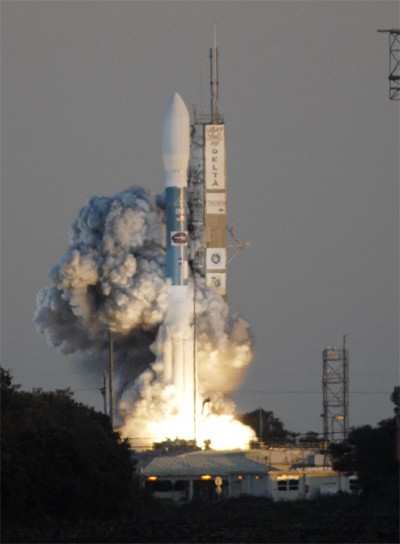Sun, Feb 18, 2007
Aurora Observation Project Underway
Five satellites... one rocket. Just past 6 pm EST Saturday,
NASA's THEMIS mission blasted off from Cape Canaveral Air Force
Station in Florida, racing into space on the flaming power of three
rocket stages and nine solid rocket motor.

Once in proper orbit, the five small satellites comprising the
Time History of Events and Macroscale Interactions during Substorms
(THEMIS) project will disperse around Earth to monitor auroras like
the Northern Lights.
NASA is undertaking the mission to investigate what causes
auroras in the Earth's atmosphere to change in appearance and
dissipate. Discovering why the light of auroras can fluctuate and
fade will provide scientists with important details on how the
planet's protective magnetosphere works and on the sun-Earth
connection.
As Aero-News reported, NASA
originally bumped the launch date to Friday, due to concerns at
Kennedy Space Center about an advancing cold front and the severe
storms accompanying it. The storms remained in the area throughout
Friday, causing stronger-than-acceptable upper-level winds and
resulting in a second 24-hour delay.
Named for the Greek goddess of justice, wisdom and good counsel,
and the guardian of oaths, THEMIS is a mission to investigate what
causes auroras in the Earth's atmosphere to dramatically change
from slowly shimmering waves of light to wildly shifting streaks of
color.
"The THEMIS mission will make a breakthrough in our
understanding of how Earth's magnetosphere stores and releases
energy from the sun and also will demonstrate the tremendous
potential that constellation missions have for space exploration,"
said Vassilis Angelopoulos, THEMIS principal investigator at the
University of California, Berkeley. "THEMIS' unique alignments also
will answer how the sun-Earth interaction is affected by Earth's
bow shock, and how 'killer electrons' at Earth's radiation belts
are accelerated."
NASA states discovering what causes auroras to change will
provide scientists with important details on how the planet's
magnetosphere works and the important Sun-Earth connection.
(Photo courtesy NASA)
More News
Airport Rotating Beacon A visual NAVAID operated at many airports. At civil airports, alternating white and green flashes indicate the location of the airport. At military airports>[...]
Aero Linx: Fly for the Culture Fly For the Culture, Inc. is a 501(c)(3) non-profit organization that serves young people interested in pursuing professions in the aviation industry>[...]
Klyde Is Having Some Issues Comprehending The Fed's Priorities FMI: www.klydemorris.com>[...]
Also: Viasat-uAvionix, UL94 Fuel Investigation, AF Materiel Command, NTSB Safety Alert Norges Luftsportforbund chose Aura Aero's little 2-seater in electric trim for their next gli>[...]
Also: EP Systems' Battery, Boeing SAF, Repeat TBM 960 Order, Japan Coast Guard H225 Buy Despite nearly 100 complaints totaling millions of dollars of potential fraud, combined with>[...]
 ANN's Daily Aero-Term (04.25.24): Airport Rotating Beacon
ANN's Daily Aero-Term (04.25.24): Airport Rotating Beacon ANN's Daily Aero-Linx (04.25.24)
ANN's Daily Aero-Linx (04.25.24) Klyde Morris (04.22.24)
Klyde Morris (04.22.24) Airborne 04.24.24: INTEGRAL E, Elixir USA, M700 RVSM
Airborne 04.24.24: INTEGRAL E, Elixir USA, M700 RVSM Airborne 04.22.24: Rotor X Worsens, Airport Fees 4 FNB?, USMC Drone Pilot
Airborne 04.22.24: Rotor X Worsens, Airport Fees 4 FNB?, USMC Drone Pilot



